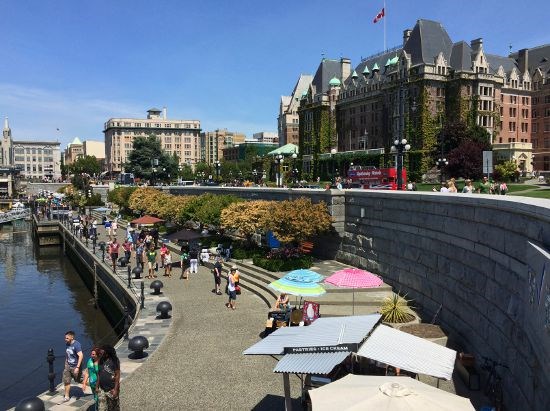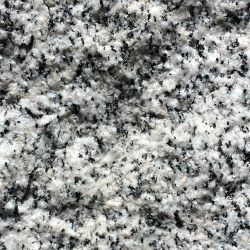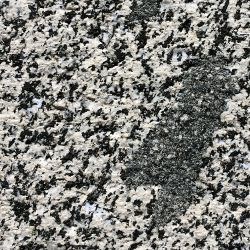Building with BC's Coastal Granodiorite EarthCache
Building with BC's Coastal Granodiorite
-
Difficulty:
-

-
Terrain:
-

Size:  (other)
(other)
Please note Use of geocaching.com services is subject to the terms and conditions
in our disclaimer.
Along with your log for this EarthCache, you need to send me an email with your answers to the questions at the end of the description. I also ask that you don't "save" your find for a different day (for example to extend a streak, fill a hole in your calendar, etc.). Please log your find for the day you visited the location.
Dimension Stone
As Victoria was growing in the late-19th century and early-20th century and many buildings were being constructed, many of them incorporated dimension stone in some form. Dimension stone is rock that has been cut and finished to predetermined requirements and used for either structural or decorative purposes. The size and form of dimension stone can vary from large blocks, to sheets or slabs, to small tiles. Nearly any stone can be used as dimension stone, but some of the most common types used are granite, marble, limestone, and slate. You likely encounter dimension stone many times every day. You might see it in the granite countertop in your kitchen, the marble monument in the park, or the slate tiles in the lobby of a building. In almost any populated area, there's likely some form of dimension stone nearby.
Granodiorite
One dimension stone that has been used in many of Victoria's buildings is granodiorite. While similar to granite, granodiorite is a bit different in that it contains more plagioclase feldspar (which contains calcium and sodium) than granite, whereas granite contains more orthoclase feldspar (which contains potassium) and more quartz. Granodiorite also tends to have more of the dark-coloured biotite - a form of mica - that gives the rock a salt-and-pepper look and makes it darker.
Granodiorite can be found in abundance in the Coast Belt, one of 5 morpho-geological belts that define the geology of British Columbia. The Coast Plutonic Complex is a band of rock underneath the mountains of the southern coastal regions of the British Columbia mainland that was formed from the late-Jurassic to Tertiary periods (155 to 24 million years ago) and contains granodiorite.
Granodiorite is an intrusive igneous rock, which is formed when magma (molten rock) cools and solidifies inside another body of rock under the surface. The rock is composed of a large amount of sodium- and calcium-rich plagioclase feldspar, some orthoclase feldspar, quartz, small amounts of muscovite mica, and knots of dark biotite.
Through the movement of tectonic plates and the erosion of the overlying rock, the granodiorite was eventually revealed at the surface where it could easily be extracted. From the mid-19th century to early-20th century, quarries were opened on several islands at the mouth of Jervis Inlet on the Sunshine Coast, about 150 km north-northwest of Victoria. The granodiorite from these quarries was used in many buildings and structures in Victoria, Vancouver, Nanaimo, and several countries around the world for its attractive appearance and durability.
Victoria Causeway Seawall
 The seawall, which rises 20 feet above the lower causeway, was built in 1903 to separate the James Bay mud flats from the Inner Harbour and allow construction of the iconic Empress Hotel. Granodiorite from Kelly Island was used for the majority of the wall, with granodiorite from Fox Island used for the capping stone and a single course of stone about two-thirds of the way up the wall.
The seawall, which rises 20 feet above the lower causeway, was built in 1903 to separate the James Bay mud flats from the Inner Harbour and allow construction of the iconic Empress Hotel. Granodiorite from Kelly Island was used for the majority of the wall, with granodiorite from Fox Island used for the capping stone and a single course of stone about two-thirds of the way up the wall.
The Kelly Island granodiorite has more black biotite in it than stone from the nearby islands, so it has a darker look to it, while the Fox Island granodiorite is lighter and coarser.
Victoria Cenotaph
 The cenotaph was dedicated on July 12, 1925 and was later updated such that it now honours the fallen from World War I, World War II, and the Korean War. It's made from granodiorite quarried on Nelson Island and was left with a rough and unpolished finish. This stone contains many small knots of darker minerals that give the stone a speckled look. The rough finish means it tends to collect and absorb dirt from the surrounding environment more easily, which makes it artificially slightly darker.
The cenotaph was dedicated on July 12, 1925 and was later updated such that it now honours the fallen from World War I, World War II, and the Korean War. It's made from granodiorite quarried on Nelson Island and was left with a rough and unpolished finish. This stone contains many small knots of darker minerals that give the stone a speckled look. The rough finish means it tends to collect and absorb dirt from the surrounding environment more easily, which makes it artificially slightly darker.
Questions
While I cannot require that you send your answers using a particular method, at this time I do request that you use the old Send Email feature rather than the new Message Center/Message this owner link. Answers sent using the Message Center will still be considered valid, but will make things more difficult on my end.
You don't need to wait for a response from me to log your find.
1. a. Find a spot along the seawall where you can view both the main wall and capping stone up close at the same time (the stairs are good spots for this). Estimate the average size of the black biotite spots/knots in both the Kelly Island (main wall) and Fox Island (capping stone) granodiorites. As a reference, the eraser on the end of a pencil is 5 millimetres wide.
1. b. Describe any differences you can see between the Kelly Island and Fox Island granodiorites. (Examples of things to compare could include the proportions of the different minerals, the colours of the minerals, the consistency of the size of the biotite spots, the overall colour/shade, etc.)
2. a. Make your way across Belleville Street to the Victoria Cenotaph (N48 25.232 W123 22.155). How does the Nelson Island granodiorite used in the monument compare to those used in the seawall? Is it more similar to the Kelly Island granodiorite (main wall) or the Fox Island granodiorite (capping stone)?
2. b. Estimate the average size of the black biotite spots/knots.
3. What type of rock is granodiorite? (Hint: You did read the description, didn't you?)
(4. Optional) Feel free to add a photo of yourself or your GPSr in the area, or even just a photo of one of the many views in this area. To help prevent armchair-logging, try not to add any photos that show the granodiorite close-up. I may ask that any such photos be removed.
Other Buildings
There are a number of other buildings or structures in the Downtown Victoria area that use coastal granodiorite in at least part of their construction:
- BC Parliament Buildings - Nelson Island granodiorite foundation, steps, and fountains
- Royal BC Museum - 675 Belleville Street - Nelson Island granodiorite base
- Old Post Office/Custom House - 816 Government Street - "Island White" granodiorite from Squamish quarry on Government Street side, Nelson Island granodiorite on older Wharf Street side
- Old Royal Bank/Munro's - 1108 Government Street - Nelson Island granodiorite
- Old Bank of Montreal/Irish Times - 1200 Government Street - Nelson Island granodiorite base
- Federal Building - 1230 Government Street - Nelson Island granodiorite base
- Ogden Point Breakwater - Hardy Island granodiorite
- Pither and Leiser Warehouse - 1019 Wharf Street - unknown coastal granodiorite base
- Yarrow Building - 645 Fort Street - unknown coastal granodiorite base
- Bastion Arcade - 535 Yates Street - unknown coastal granodiorite base
- Christ Church Cathedral - 951 Quadra Street - unknown coastal granodiorite base
- Yorkshire Trust Building - 737 Fort Street - unknown coastal granodiorite base
- Douglas Obelisk - Belleville Street - unknown coastal granodiorite

Old Post Office - "Island White" granodiorite (Squamish)
|

Old Post Office - Nelson Island granodiorite
|

Douglas Obelisk - Unknown coastal granodiorite
|

BC Parliament Building Foundation - Nelson Island granodiorite
|

Christ Church Cathedral - Unknown coastal granodiorite
|
Bibliography
- Peter S. Fischl, Ministry of Energy and Mines - MINFILE 092F 196, November 13, 1996
- Laura deGroot, Ministry of Energy and Mines - MINFILE 092F 378, September 20, 2012
- Sarah Meredith-Jones, Ministry of Energy and Mines - MINFILE 092F 189, August 19, 2009
- Z.D. Hora and L.B. Miller, Dimension Stone in Victoria, B.C. - A City Guide & Walking Tour, 1994
- Zdenek D. Hora, Kirk D. Hancock, Geology of the British Columbia Parliament Buildings, Victoria, Geoscience Canada Volume 35, Number 2 (2008)
- Wikipedia - Granodiorite
Additional Hints
(No hints available.)